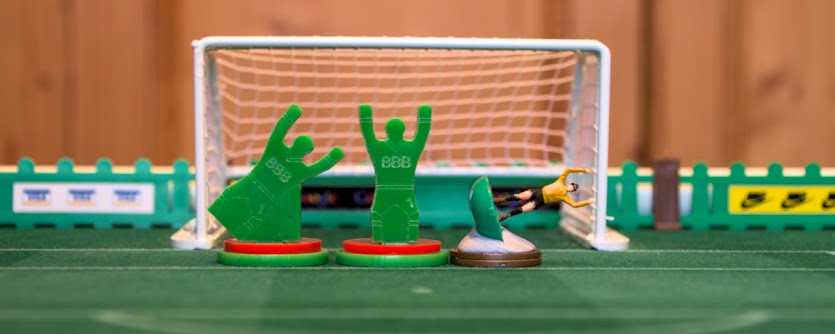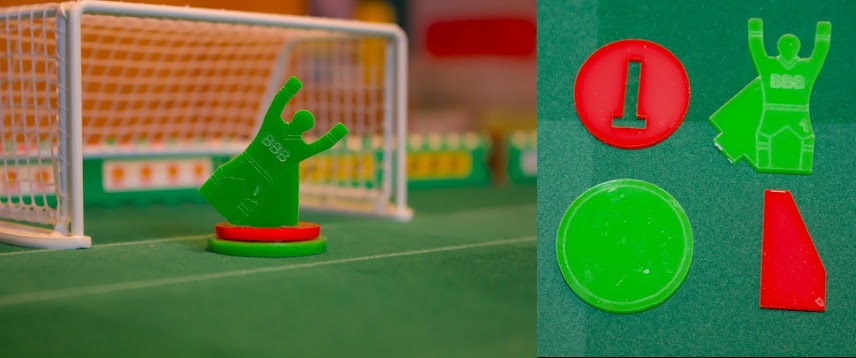I’ve
been contacted by my good friend David Forsyth who has been mentioned
on this blog before, and kindly submitted the post “A flat back
four”. Well David sent me a rule from the 60’s Advanced rules
which he incorporates into his solo play. David almost exclusively
plays to the 1968 Advanced rules with his own twist on things to make
them suit his style of solo play. Now I’m from the same kind of era
as David but must admit I’ve never played to the late 60’s
Advanced rules at all, because by 1971 I was a member of a Club. So
what? you may ask, Well to cut a long story as short as possible I’ll
tell you, and if you don’t just scroll past the next paragraph but
be warned you could be missing this weeks free gift!
Not
quite Subbuteo
The
rules used for competition at that time (at our Club) differed
slightly from the Subbuteo Advanced Rules, especially when it came to
blocking. At Club level blocking flicks were alternate to the
attacking flicks just like they are now. They had been like that for
a good few years before I joined the Club, and because my Uncle was
secretary of the Club I was inaugurated into the game by him and was
taught to play this way. So the 60’s Subbuteo Advanced rules sort
of passed me by. We played by I think, and no quoting me on this ETF
rules at that time not SSG. So anyone who had got into the game at
this time and played to the box set advanced rules had to adjust to
different rules at Club level depending on who the Club was
affiliated to. To be honest and looking back at it now, it was all a
bit messy. If you want to know more about the history of the rules
and associations during this time head off to the Peter Uptons
tribute site a link is on the links page, (funnily enough it seemed
like a good place to put a link). Oh by the way I lied about the free
gift!!
Lets
get back on track
Well
anyway back to David and the “Organising
Rule”, as he puts it, I’ve set down below as it was sent to me
for your perusal, and hopefully you will see how and why he
incorporates it within his games.
Organising
Rule: Lesser-Known
but Useful?
Tucked
away almost inconspicuously in the Advanced Rules of the 1960s is a
brief sentence about how a side may organise.
To
explain it as succinctly as I can this rule states:
i)
When a team has possession, and the ball isn’t in either shooting
area, a side may organise and position (by hand) up to three playing
figures in it’s own shooting area. (Note; some rewrites of
these rules allow four, or even five figures to be
moved, to allow for modern playing formations.The
choice is up to the individual, although I prefer to stay with
three).
ii)
If there are fewer than three players already there, that number can
be made up by moving back players from outside the area, provided any
player moved is behind the ball, and not the nearest player to it.
(so you can’t move back your overlapping full back who has got
trapped up the field while helping the attack!).
Limitations:
iii)
Organising can only be used once per period of possession.
iv)
A playing figure which has been moved, may not play the ball until
another figure from the same team has done so.
In the left hand photo white have possession of the ball outside their shooting area, which allows them to organise their defensive line by moving the 3 defenders in the penalty area (photo on the right). Note by doing this they have also made the blue attacker offside.
The
case for the defence
In
the solo game, organising has two distinct advantages: it can give
the panoramic view of the pitch a more realistic appearance (no
defenders loitering beside a corner flag when the play is much
further forward), and also, if blocking flicks are used, they can
have a more direct influence on the immediate play. Organising can
replace, assist or reduce defensive flicks, whichever the player
prefers
.
Also,
surely it’s better to challenge ourselves by playing against
defences in a realistic formation, rather than still have a massive
gap to play through during an attacking move which began inside a
team’s own half.
I
should mention that I am aware many traditional Subbuteo players
don’t like the organising rule, as they believe the game should be
more about flicking, with less positioning by hand. I respect that
view, but in solo play positioning quickens up the process of getting
teams in the right formations, and therefore time within a game to
get on with meaningful playing.
N.B.
For those of you who wish to locate the original rule, in the 1967
Advanced rules, it is described in Rule 7 (b) and (c),, and also in a
footnote at the end.
David
Forsyth
My
Thoughts
I
can see the reasoning of this method as a way of getting your defence
organised within the context of the rules at that time, and it
certainly allows itself to be incorporated into solo play I think
more so than competitive play, but that's a whole new ball game and
not what this blog is about. It all depends on how you want to play,
I can see it could help the formation of a defensive line in solo
play especially if you don’t use blocking
or
limited blocking flicks
as I use, but what's to stop one putting a barrier in front of the
goalkeeper, is the keepers area the 6 yard box or the 18 yard box,
I’m
presuming the 6 yard box, (don’t
you just love these old rules they can be so precise whilst being so
vague at the same time). You
can cherry pick rules from different eras of the game but I’ve
found you have to consider not just the rules you adopt but it’s
impact on any other rules you play, some form of balance needs to be
maintained. David plays to the advanced rules from this era so that
balance has been achieved with little
tweaks
for his
solo
play. I
on the other hand when I play tested it found that it didn’t
integrate well with the rules I have adopted. I’m not going to go
into that now because we probably all play a little differently when
playing solo and it’s up to you the individual to decide whether
organising would be something you would adopt or
think could be of benefit for your games. On the “Downloads” page
of this blog there
are copies of the 1967 and 1969 Advanced rules which you can download
with my blessing. From
them you can see how SSG incorporated them into the game at that
time.
I’ll
take this opportunity to thank David for his
contribution,
It’s always great to hear the views and rules that other players
have and use, they are always welcome as it keeps giving other
players options as well as keeping the grey matter working.
Keep
On Flicking.




Comments
Post a Comment